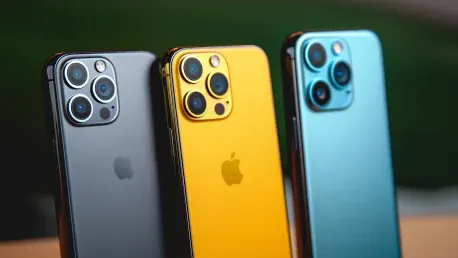The recent announcement of a 10% tariff on Chinese imports by President Donald Trump has sparked concerns about potential price hikes for smartphones. While the initial reaction may be to expect immediate cost increases, various factors suggest that consumers might not feel the impact right away. This article delves into the complexities of the situation, examining how current market dynamics and consumer behaviors could mitigate the effects of these tariffs.
Delayed Impact on Smartphone Prices
Timing of Price Increases
Analysts predict that any price hikes resulting from the tariffs will not be immediate. The delay is attributed to the release schedules of major smartphone manufacturers, such as Apple, which typically launch new models later in the year. This timing means that consumers may not experience higher prices until the holiday season. However, the ripple effects of the tariffs are complex, as manufacturers and supply chains adjust to the new economic landscape.
The strategic nature of product releases might contribute to the delay in price increases. Manufacturers often have pre-existing contracts with suppliers and may use existing inventory to buffer the impact of the tariffs. Additionally, companies might absorb some of the costs in the short term to maintain their market share, only passing on the increased costs to consumers once new model year devices are introduced. This strategic delay allows for better planning and less abrupt price changes.
Existing Stock and Secondhand Market
A significant portion of smartphones available in the U.S. are already in the country, either stored in warehouses or circulating in the secondhand market. This existing stock can act as a buffer, preventing immediate price increases. The growing market for used and refurbished smartphones also provides consumers with more affordable options, further mitigating the impact of tariffs. Furthermore, retailers might prioritize selling their current inventory before adjusting prices on new shipments.
The influence of the secondhand market on overall smartphone prices is substantial. As consumers become more comfortable purchasing gently used or refurbished devices, the pressure on new smartphone prices diminishes. This trend has been bolstered by the increasing quality and reliability of refurbished phones, often supported by strong warranties and guarantees. In this landscape, the combination of existing stock and a robust secondary market plays a pivotal role in shielding consumers from immediate price hikes.
Consumer Financing and Promotional Strategies
Monthly Installment Plans
Many U.S. consumers purchase smartphones through monthly installment plans offered by carriers and retailers. These plans can cushion the impact of price hikes, as a $100 increase in the cost of a smartphone might only result in a modest rise in monthly payments. This financing method helps spread out the cost, making it more manageable for consumers. The convenience of paying a small amount monthly instead of a large upfront fee appeals to many buyers, softening the blow of potential price increases.
Carriers and retailers may also leverage these installment plans to retain customer loyalty. Customers locked into multi-year payment plans are less likely to switch to competing brands or carriers. This dynamic creates a more stable market environment, limiting the need for drastic price adjustments. Additionally, promotional offers tied to these plans, such as zero-interest financing or bundled service discounts, can further alleviate the impact of price increases.
Promotional Discounts and Trade-In Deals
Carriers frequently offer promotional discounts and trade-in deals, especially during the launch of new high-profile phones like the iPhone series. These promotions can significantly reduce the upfront cost of new devices, allowing consumers to avoid the full brunt of tariff-induced price increases. By trading in older devices, consumers can take advantage of substantial discounts, further alleviating financial strain. Promotions are particularly effective during key sales periods such as Black Friday or the back-to-school season, making smartphones more accessible despite potential tariffs.
These strategic promotional efforts not only attract new buyers but also encourage existing customers to upgrade their devices more frequently. As a result, the perceived impact of tariff-induced price increases is mitigated by the savings and value derived from promotional deals. Additionally, these promotions often come with extended warranties, protective accessories, or free subscriptions to services, enhancing the overall value proposition for the consumer.
Complex Pricing Dynamics
Factors Beyond Tariffs
The pricing of new smartphones is influenced by various factors beyond tariffs, including competition, component costs, and long-term supply chain agreements. These complexities mean that tariffs may not directly lead to higher consumer prices in all cases. Manufacturers may absorb some of the costs or find alternative ways to offset the impact of tariffs. For instance, companies might seek to renegotiate supplier contracts, streamline production processes, or increase efficiency to maintain competitive pricing.
Additionally, fluctuations in currency exchange rates and global economic conditions can also affect smartphone pricing. Companies are often engaged in hedging strategies to protect against cost volatility. These strategic financial moves help to stabilize prices and reduce the immediate impact of tariff-related cost increases. As such, the ultimate effect on consumer prices is the result of a confluence of factors, rather than tariffs alone.
Market Competition
Intense competition among smartphone manufacturers can also play a role in mitigating price increases. Companies may be reluctant to raise prices significantly for fear of losing market share to competitors. This competitive pressure can help keep prices stable, even in the face of new tariffs. Manufacturers might opt to differentiate their products through features, services, and brand loyalty rather than engaging in direct price competition, thereby protecting consumers from abrupt cost escalations.
Furthermore, competitive dynamics can stimulate innovation, as companies seek to offer more value and better performance to justify their price points. This innovation-driven approach often leads to improved product offerings without corresponding price hikes. The competitive landscape acts as a natural check against price inflation, ensuring that consumers continue to receive high-quality products at fair prices despite potential tariff pressures.
Growth of the Used Smartphone Market
Increasing Popularity of Pre-Owned Devices
The market for used and refurbished smartphones is expanding rapidly. In 2023, there was a significant increase in global shipments of pre-owned smartphones. This trend highlights a growing consumer preference for buying used devices, which can offer a more cost-effective alternative to new models. The environmental benefits of opting for refurbished phones also appeal to eco-conscious consumers, further driving the popularity of this market segment.
The proliferation of reputable sellers and certified refurbished programs has enhanced consumer confidence in pre-owned devices. Many of these programs offer comprehensive testing, repairs, and warranties, ensuring that refurbished phones meet high standards of quality. As a result, the barrier to entry for consumers considering pre-owned devices is lowered, making it a viable option for those looking to save money without sacrificing quality.
Quality and Availability of Refurbished Phones
Refurbished smartphones are often nearly as good as new ones, providing consumers with high-quality options at lower prices. The increased availability of these devices, coupled with warranties and guarantees offered by sellers, makes them an attractive choice for budget-conscious consumers. This growing market segment can help offset the impact of tariff-induced price hikes on new smartphones. Trusted platforms and retailer certifications also play a crucial role in assuring customers about the reliability of refurbished devices.
Moreover, the lifecycle of smartphones has extended, with many users now holding onto their devices longer before upgrading. This behavior contributes to a more robust supply of well-maintained used phones in the secondary market. As manufacturers and retailers recognize the value of this market, they are likely to invest more in refurbishing and reselling programs, further solidifying the presence of high-quality, affordable alternatives to new smartphones.
Future Considerations and Consumer Adaptation
President Donald Trump’s recent announcement of a 10% tariff on Chinese imports has raised concerns about the possibility of price increases for smartphones. Although the immediate reaction might be to expect a swift rise in costs, various factors indicate that consumers could be shielded from these changes in the short term. This article explores the intricacies of this development, analyzing how current market conditions and buying behaviors might help to alleviate the potential impact of the tariffs.
For instance, many smartphone manufacturers have already stockpiled inventory in anticipation of such economic measures, which could delay price hikes. Additionally, the competitive nature of the smartphone market might compel companies to absorb some of the extra costs rather than pass them onto consumers right away. Furthermore, consumer loyalty and purchasing power play significant roles; brands may choose to keep prices stable to maintain their customer base and market share.
In summary, while the new tariffs undoubtedly pose challenges, a combination of strategic inventory management, market competition, and consumer-focused approaches might soften the immediate blow on smartphone prices.









